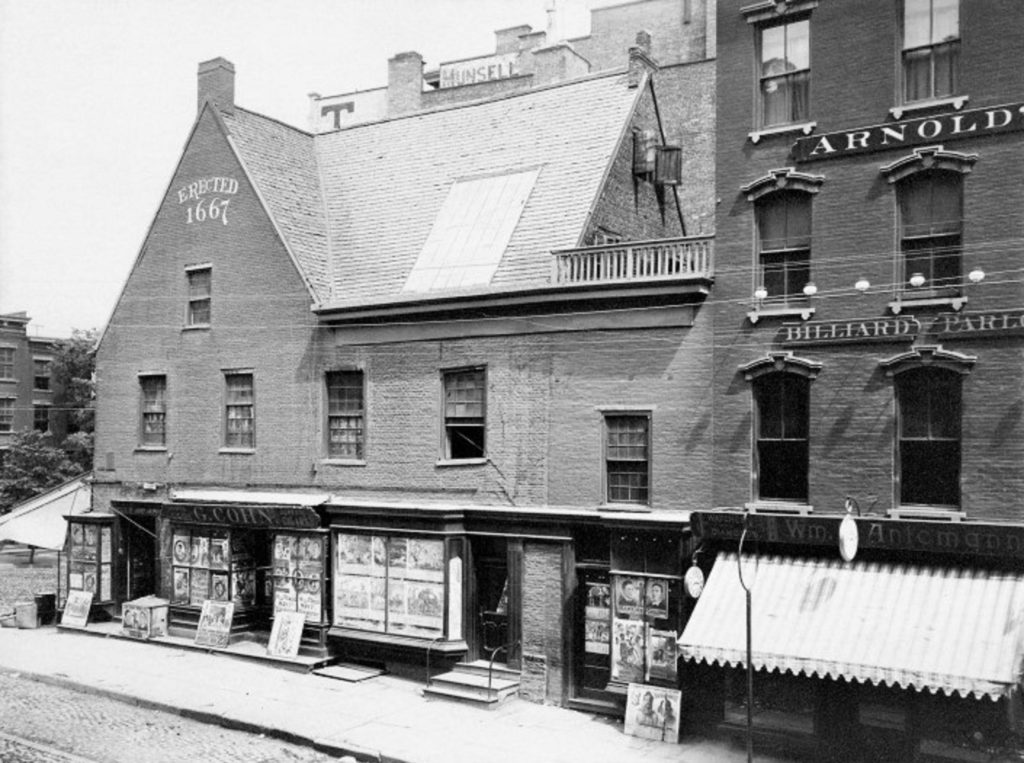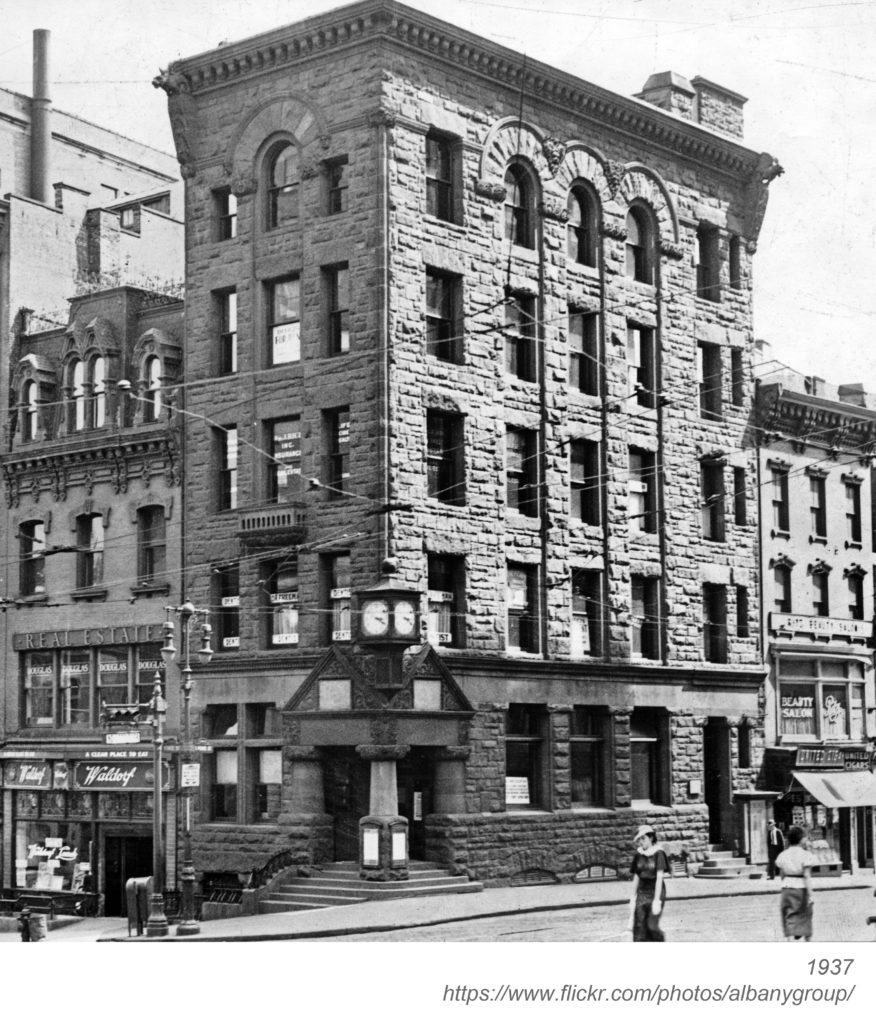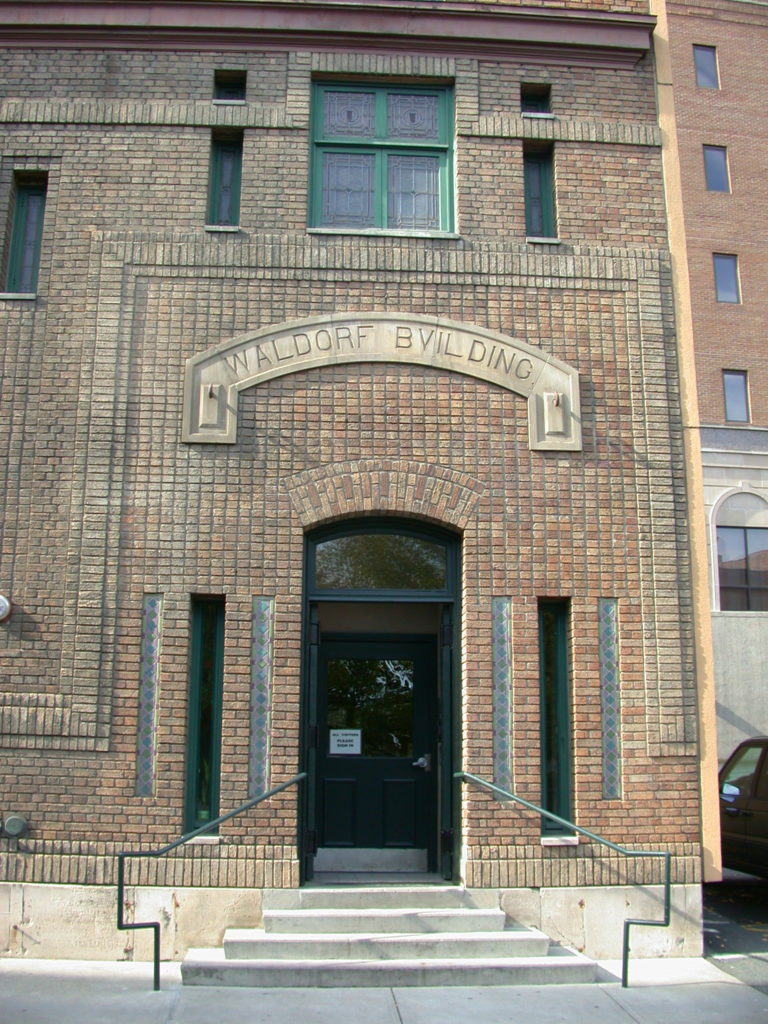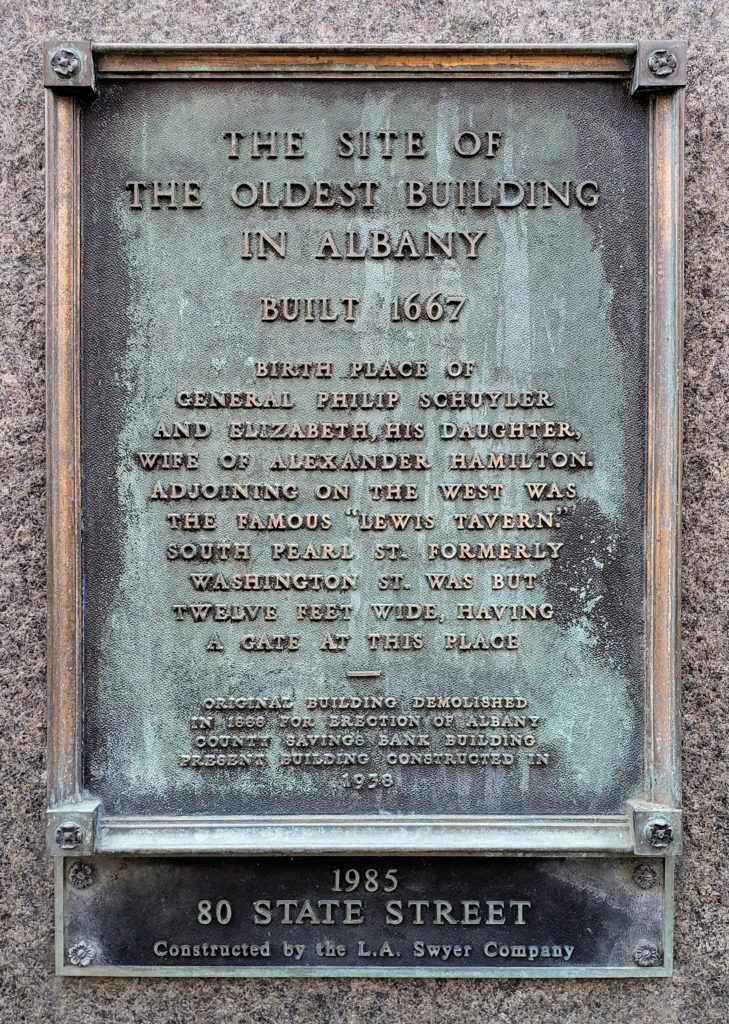Continuing our series on the tablets placed around Albany in honor of the bicentennial of the city’s charter, celebrated in 1886, we have a replacement marker on a site that has seen a lot, and has been occupied almost as long as Albany has been here. The original marker placed by the Bicentennial Committee read as follows:
Tablet No. 15 — Oldest Building in Albany
Located in south-east corner of State and North Pearl streets—Bronze tablet, 16×22 inches, inserted in Pearl street wall of Staats’ house. Inscription :
“The Oldest Building in Albany—Built 1667. Birthplace of Gen. Philip Schuyler And Elizabeth Schuyler, wife of Alexander Hamilton—Adjoining on the West was the Famous ‘Lewis Tavern.’ South Pearl street was formerly Washington Street and was but twelve feet wide, having a Gate at this place.”
Of course, Staats’ house, originally the Schuyler family home, on the southeast corner of State and North Pearl, is long, long gone. Staats House was demolished in 1887 to make room for the Albany County Savings Bank Building. It’s a little ironic that the plaque declaring the oldest building in Albany may not have lasted a year on that actual oldest building.
What happened to the tablet? Unknown. It was reported that in 1914 it was placed on the Albany County Savings Bank building that was built there, “with a smaller tablet of similar design below it bearing the following inscription: ‘The above tablet removed from building formerly on this site and replaced A.D. 1888.’”
Both those tablets have disappeared. Happily, though, they have been replaced. (Keep on reading.)
Schuyler House
Albany’s Historic Street, a 1918 collection “of some of the Historic Facts and Interesting Traditions relating to State Street & Its Neighborhood,” published in commemoration of the 50th anniversary of the National Savings Bank of the City of Albany, provided a succinct description of the house marked by this tablet during its years owned by the Schuyler family:
“Another interesting historic house in early State Street was the Staats house, and the famous Lewis Tavern adjoining it. The building was really a double house, built in 1667, a little more than a decade after the erection of the Old Dutch Church. Historically, the site is one of the most important in the city. Originally, this lot, now occupied by the Albany County Savings Bank, at the southeast corner of State and South Pearl Streets, was granted to one Cornelis Steenwyck, who, it is claimed, transferred the property to Colonel Philip Pieterse Schuyler, the ancestor of the Schuylers in America. The double house erected on the site was built of bricks brought from Holland, an an interesting feature of the building was the ‘Anno Domini 1667’ that extended across the gable end. After the demolition of the western half in order to widen Pearl Street, the eastern half still retained the ‘Anno’ and in fact the date, until the owner, fancying that the ancient year so boldly carved on his property was detrimental to its rental, had the figures removed.
“Colonel Schuyler left his property to his youngest son, Johannes, who used the double house as a residence. This son was a rich fur-trader in the city, and eventually became mayor of Albany. On his death his son, Johannes, Jr., took up his residence there; and his son, General Philip Schuyler, was born in the house on November 11, 1735. This was Madam Schuyler’s city residence, and here she lived while her house at the Flats was being rebuilt. Madam Schuyler will be remembered as the ‘American Lady’ of Mrs. Grant’s Memoirs. The house during the time of her occupancy is said to have been elaborately furnished. The property came into the possession of the Staats family about 1777.”
Diana Waite, in Albany Architecture, provides some more detail, indicating that Philip Pieterse Schuyler bought the lot at State and Pearl, and had a house built on the east part of the lot about 1659. In 1667, when his title to the lot was confirmed under English rule, Schuyler built a second house on the western portion of the lot and replaced or remodeled the east house to match. “Across the front of both houses, facing State Street, he placed the bold iron figures ‘ANNO 1667.’”
The remaining “ANNO” lettering can be seen on the State Street side of the east house quite clearly in the photograph, while a much more recently painted “Erected 1667” appears high on the Pearl Street side. Waite said that this is the oldest building in Albany of which a photograph exists.

Schuyler’s granddaughter Margarita Schuyler moved into the west house about 1763, and lived there until her death in 1782; after that, the west house became the City Tavern, and Lewis’s Tavern. It was demolished in 1798 in order to widen South Pearl Street. The east house was purchased in 1777 by Henry Staats, and Waite says that at the time it was already “held” by Richard Cartwright, a tavern keeper and merchant who had been transported to North America as a convict in 1743.
Lewis’s tavern is frequently mentioned in association with the Staats house – it was in the western half of the house that was torn down to accommodate a wider Pearl Street. Again according to “Albany’s Historic Street,” Robert Lewis was a Yankee (New Englander) who came to New York after the revolution; “his hostelry was the best-known and most generally patronized until the opening of the Tontine Coffee House.” Stage coaches serving the surrounding area used the tavern as their starting point. What sorts of things went on there? Oh, the usual great events of a city: a celebration of the city’s charter centennial in 1786; incorporation of the Bank of Albany in 1792; a dinner in honor of Governor George Clinton and Dutch ambassador Heere P.J. Van Berkel in 1784. And, um, “It was at this tavern in 1784 that ‘a likely negro wench,’ owned by Mrs. Margaret Schuyler, was offered for sale.”
Now, to be slightly fair to the renewedly famous Peggy Schuyler, while she did own enslaved persons, this sale only came about because she had died; it was in fact the executors of her estate who made this famous offer at a sale held on Oct. 21, 1784, according to Munsell’s “Notes From the Newspapers” section of “The Annals of Albany.” It is likely this same unnamed “wench,” and we’re very sorry not to be able to identify the woman, who is noted in Alexander Hamilton’s cash book, where he recorded transactions undertaken on behalf of his legal clients. In it, Hamilton seems to record a £90 payment from Dr. Malachi Treat of New York City, “To a negro wench Peggy sold him.” (Given the context, it seems likely that Hamilton meant that this was a payment to the account, not a payment of a very large sum to an enslaved woman not even mentioned by name. In other words, this is likely the price for her.) It is worthy of note, too, that Hamilton’s wife, Elizabeth Schuyler, is said to have been born in the Staats House on August 9, 1757 (four years or so before the Schuyler Mansion was built).
The Staats Family
Even though the Schuylers built and occupied the house for 115 years, the house came to be known as Staats House – perhaps to avoid confusion with the Schuyler Mansion. But that’s also a bit confusing, because the Staats are one of the Albany area’s oldest families, and one might easily assume the Staats House to be one of their early residences, but that is not the case.
Abraham Staats came to New Netherlands in 1642; his numerous descendants lived inside and outside of the Albany stockade, and spread through the region, probably most famously at the farm on Staats Island (no longer an island) in the Hudson River north of modern Castleton.
The New York State Museum’s Stefan Bielinski wrote that the east building was sold to Henry and William Staats, merchants and shippers. Diana Waite, in “Albany Architecture,” dates that sale to 1777. As noted above, Cartwright may have continued his tavern there, along with some sort of retail. Henry’s widow, Ann Lott Staats, owned the building after his death in 1814, and continued its use as both business and residence; their sons were druggists in this space. Ann died in 1829, aged 82.
When it passed from the Staats family, we are not certain. Retail of various sorts continued in the Staats House. A. Wolenman opened a fruit store on the State Street side of the Staats House in 1840; he later partnered with J.L. Lochner. (The business was still a going concern in 1912, when construction of a new hotel on the site forced a move to Broadway.) Various other businesses, lawyers and others operated out of the Staats House in the latter part of the 19th century. A photograph from the Albany Institute of History and Art shows the Pearl Street side, windows papered over as Gilbert Cohn’s cigar shop prepares to move out.

The Albany County Savings Bank sought the property to build a new headquarters and got tied up in litigation over the purchase in 1885. A Mrs. Blanche Kelly sold her half of the property to the bank; the remaining half appears to have been mortgaged by Adaline Alexander; a circuit court ordered the completion of the sale of the property, which was then valued at $36,000, and the bank was able to proceed with construction. It was reported that when the old Staats House was torn down, bricks were taken by many Albanians.
In 1941, The Knickerbocker News reported that relics from the Staats House had been given to the Albany Institute of History and Art. William and Louisa Benson donated four Dutch tiles and a brick from the house collected by their father, Albert Van Voast Benson, who was a secretary of the Albany County Savings Bank. The Knick reported that the institute also had other tiles from the fire places of the Staats House, “and a bronze lion, one of a pair of mantle decorations in the old structure.” The lion had belonged to Albany painter Asa B. Twitchell, who gave them to Michael de Scherbinin, whose estate gave them to the Institute. (We presume these items remain in the Institute’s collection, and may have even been part of the display in the legendary and lamented “Dutch Room.” A quick online search, however, did not locate them.)
Albany County Savings Bank
Several sources indicate that the Albany County Savings Bank, chartered on April 30, 1874, began its business on the ground floor of Tweddle Hall, catercorner from this location. After the 1883 fire that destroyed Tweddle Hall, the bank moved “hastily” to 71 State street, where it somehow opened the same morning as the fire. According to The Story of Albany from 1924, the bank quickly outgrew that space and so looked at what they considered the most central commercial location in the city, the old Staats house, which they bought after some legal wrangling in December 1887; their new stone building was completed by May 1, 1888.
They took an odd pride in place, offering without irony that they had destroyed the oldest house in the city in order to occupy its site: “Even without considering its steady growth, the Albany County Savings Bank certainly commends itself for progressiveness, when it is considered that it selected a site whereon stood the oldest house in the city; removed it, and erected thereon the first of all the modern bank buildings which make Albany so architecturally attractive.” They hired distinguished Albany architects Fuller and Wheeler to do to the deed and built what was often known as the “Chime Clock Building,” and the bank frequently referred to as the “Chime Clock Bank,” so named for an obvious feature at its entrance.

In 1935, the Albany County Savings Bank merged with with the considerably larger Albany City Savings Bank (formerly Albany City Savings Institution, from 1850-1921), to form the Albany City and County Savings Bank. (All these institutions were completely separate from Albany Savings Bank, and, yes, confusion reigned.) It then moved into the Institution’s building at 100 State Street (the 1901 Marcus Reynolds structure that still stands today), leaving the old corner building behind.
Without much mention or fanfare, a permit to demolish the old Albany County Savings Bank building was issued in 1937. “This structure and buildings adjoining, will make way for a new, modern office building, one of the major developments in Albany scheduled for the summer.”
During the replacement of the not-quite-50-year-old building, in January 1938, contractors found a stone in the foundation. Placed upside down, it had the initials S.V.S., followed by the date 1726. The Albany Evening Journal at the time speculated that the initials referred to a member of the Van Schlichtenhorst family; Margaretta Van Schlichtenhorst, daughter of Rensselaerwyck director Brandt Van Schlichtenhorst, marred Philip Pieterse Schuyler in 1650, who eventually owned this property and built the original house in 1667. But it was also allowed it could refer to a Van Schaick, among other possibilities. The contractor who found it, Anthony Marinello, speculated that the stone may have been inserted in the wall during a reconstruction of the old Schuyler house, a reasonable assumption. “A ruder hand at some time turned it upside down, making the markings difficult to read,” the Journal wrote. It also said: “Whether the stone will remain in the wall has not yet been decided on.”
Rudolph’s Jewelers and Waldorf Lunch
Rudolph’s was a prominent jeweler and optician that had several locations through the years; prior to moving to the building they shared with the Waldorf at the former location of Staats House, they were located at 68 State Street. They opened a sleek, “streamlined” new jewelry store on Feb. 4, 1938, an exterior design of white marble with red marble trim, an interior that featured air conditioning (“the first air-conditioned jewelry store in Albany”) and indirect lighting. More than just jewelry, Rudolph’s sold eyeglasses, watches (Bulova, Elgin, Hamilton and Benrus) and clocks (Seth Thomas), silverware, cameras, radios (Emerson and Motorola) , pens (Parker and Shaeffer) and electrical appliances (Manning and Bowman). Its vault was protected by “a special device [that] releases a discharge and rush of tear gas which continues four hours.”

Rudolph’s wasn’t the only tenant of the sleek little two-story building. There was once a chain of restaurants known as the Waldorf Lunch System, focusing on clean, simple reliable food in uniform portions served in a sanitary setting (which was a long way from guaranteed in the diners of the day). Beginning in Springfield, Mass. in 1904, this chain of white-tiled lunchrooms boasting four inspections daily and “housekeeping to beat the Dutch” grew quickly and there were 147 Waldorf Lunches by 1929. Many were open 24 hours. They were in Albany at least as early as 1908 (at Westerlo and South Pearl first, then at 84 State, the site we’re concerned with today). In 1938, Albany featured five different Waldorf locations: 84 and 134 State, 564 Broadway, 29 Maiden Lane, and 62 Madison Ave. They had already been in the building next to the Albany County Savings Bank when the bank building was removed to make room for the new Rudolph’s.
At some point before 1960, the Waldorf System was gone (though there was still something in operation in the Waldorf Building at 24 James). Rudolph’s continued in operation, and also branched out to the area malls. Just how long it held on, we’re not currently sure, but the building lasted until 1983, when it was torn down to make room for another glass skyscraper, commonly thought of as the IBM Building as an IBM sign has been featured there prominently for decades. But formally, the building’s name is 80 State Street.

The tablet
In 1914, the Argus listed this bicentennial marker as a tablet that had been replaced, and only very shortly after it had been installed. The Argus wrote: “When the Staats House, on the southeast corner of State and Pearl streets, the birthplace of Philip Schuyler, was removed and the Albany County Savings bank building erected, tablet No. 15, ‘Oldest Building in Albany,’ was replaced with a smaller tablet of similar design below it bearing the following inscription: ‘The above tablet removed from building formerly on this site and replaced A.D. 1888.”
So the original plaque was installed in 1886, and likely removed when Staats House was demolished in very late 1887, and put back up with an explanatory plaque below it in 1888.
Both the original and the explanatory plaque seem to have disappeared when the Rudolph’s Jewelers / Waldorf Lunch building was constructed in 1938, but a new plaque was created. It largely echoed the original marker’s copy, and added “Original building demolished in 1888 for erection of Albany County Savings Bank building. Present building constructed in 1938.”

While still indicating the site of what was, in 1886, the oldest building in Albany, it makes no mention of the bicentennial, and in so doing creates the rather wrong impression that the building was the first building in Albany ever, which of course it was not. It was simply the oldest building standing in 1886, and the oldest building of which we have a photograph.
Full credit to the L.A. Swyer Company for making sure that at least this replacement marker survived, and they augmented it with a marker of their own indicating the construction of 80 State Street in 1985. (And huge thanks to Al Quaglieri for getting us a current photograph of the tablets that are on the wall of 80 State Street today. And to the Albany Group Archive and Friends of Albany History.)

Leave a Reply